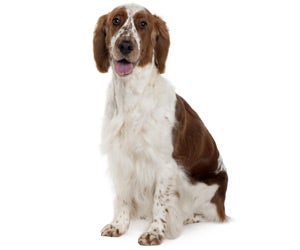Welsh Springer Spaniel
-
Overview
View Grooming Diagram for welsh springer spanielWelsh Springer Spaniels are not to be confused with English Springer Spaniels. They are slightly smaller and less hyper than those dogs from the neighboring isle. These active, playful dogs expect to bond closely with their family. Their feathered coats require frequent brushing and attention, so plan to spend lots of time with these loving family companions.
-
Personality
Welsh Springer Spaniels are quick learners who love to play and run. They have plenty of stamina and are seemingly undeterred by weather, so they will want to be vigorously exercised every day. Welsh Springers are not particularly outgoing with strangers. These devoted dogs prefer to stick to their family, often following them around at a very close clip. They will benefit from frequent socialization so they do not get stressed or timid when meeting new people.
Welsh Springers have soft eyes and a gentle expression, which indicates that they are easygoing and eager to please. They respond best to patient, understanding training. They sometimes have trouble with house-training and can occasionally be independent if they do not trust the person giving them commands. If they are treated with care and a gentle hand, they will quickly trust their owners and become incredibly loyal dogs.
-
Coat Care
The Welsh Springer Spaniel's coat comes in shades of red and white. The hair is flat and straight, but dense enough to protect the Welsh Springer from cold water and harsh weather. The coat is soft to the touch. It gets its distinctive long appearance from the moderate feathering around the ears, tail and underbelly.

Brush your Welsh Springer Spaniel regularly so their coat does not get matted or look dirty. Welsh Springers should not have excessively long coats, so to prevent them from becoming overgrown, trim and brush the feathered areas carefully.
With preparation, perseverance and a positive attitude, bathing can become a fun and fulfilling part of the regular grooming cycle, while helping your dog avoid many diseases and infections.
The general rule of thumb for dog bathing is every three months but it's generally best to bathe dogs with silky coats more often. The coat should end up fresh smelling, light and shiny, with no loose or shedding hair. First give the dog a good brushing to remove dead hair and mats. Place a rubber mat in the tub to provide secure footing and fill the tub with three to four inches of lukewarm water. Use a spray hose, pitcher or unbreakable cup to wet the dog, taking caution to avoid getting water in the eyes, ears and nose. Massage in pet shampoo, saving the head for last. Immediately rinse thoroughly, starting with the head to prevent soap from dripping into the eyes. Towel dry.
Welsh Springers should not have excessively long coats, so to prevent them from becoming overgrown, trim and brush the feathered areas carefully. Some light trimming to even out the coat might help make your dog more comfortable.
Many dog owners are apprehensive about trimming their dog’s nails because they are nervous about cutting into the quick. But with the right conditioning and careful cutting, nail clipping can be a simple, stress-free activity for you and your dog.
Provide your dog with plenty of positive reinforcement and even treats to help associate nail clipping with a positive experience. As you start to clip, gently press on your dog’s paws to help him become accustomed to the feeling of having his nails clipped. Then, work gradually, shaving down just a thin portion of the nail at first to make sure you don’t reach the quick. Clip one nail, reward your dog with a treat, and stop to give him some positive reinforcement before moving on. Gradually increase the number of nails you clip in one sitting to help your dog get used to the process. Never trim extremely long nails down to a short nail in one sitting, because this is an excellent way to accidently quick the dog’s nail. Instead, work gradually, shaving small portions of your dog’s nails off each time.
You can tell if you’re getting close to the quick by the texture of your dog’s nail. The nail is hard closer to the surface and becomes softer as you get closer to the quick. If your dog’s nail starts to feel softer, that’s a good indication that you’re getting close to the quick.
Their long, silky pendant ears are particularly sensitive, so brush them gentle and check them for infection frequently.
Many owners do not realize how important it is to brush your pet’s teeth on a regular basis. Some dogs are prone to dental problems and sensitive teeth, especially small dogs with tiny teeth and dogs with special diets. These problems can be easily combatted with frequent brushing.
Cavities are rare with dogs but gum disease caused by tartar buildup is not, which is why they require regular brushing with toothpaste and a toothbrush formulated specifically for dogs. While daily brushing is ideal, doing so on a weekly basis will be a big help in avoiding the need to bring your dog to a veterinarian for a cleaning, which usually has to be done under sedation.

 India (English)
India (English)
 Middle East and Africa (English)
Middle East and Africa (English)
 South Africa (English)
South Africa (English)
 Australia (English)
Australia (English)
 Japan (日本語)
Japan (日本語)
 South East Asia (English)
South East Asia (English)
 Singapore (English)
Singapore (English)
 Europe (English)
Europe (English)
 United Kingdom (English)
United Kingdom (English)
 Argentina (Español)
Argentina (Español)
 Brazil (Portuguese)
Brazil (Portuguese)
 Colombia (Español)
Colombia (Español)
 Latin America (Español)
Latin America (Español)
 México (Español)
México (Español)
 Chile (Español)
Chile (Español)
 Peru (Español)
Peru (Español)
 Canada (English)
Canada (English)

